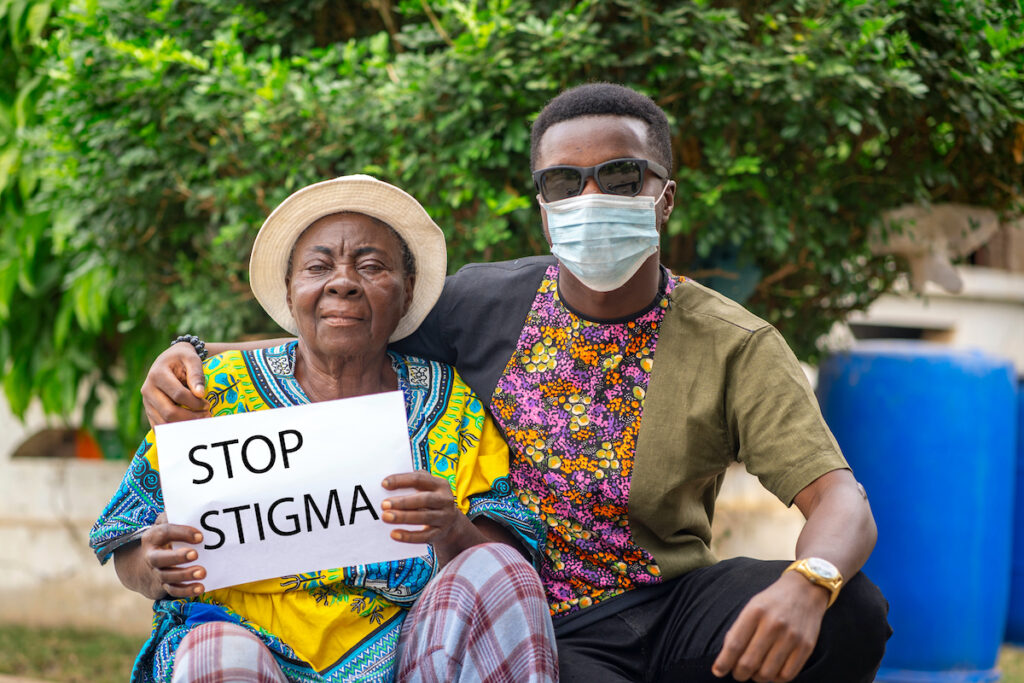
Within the United Kingdom, in 2020, around 4,900 individuals took their own life (Office for National Statistics, 2021). Those bereaved by suicide experience adverse mental health outcomes, including suicidal ideation, depression, and post-traumatic stress disorder (McDonnell et al., 2020). These individuals also experience higher levels of stigma than individuals bereaved by other means, which limits their help-seeking behaviour (Pitman et al., 2016).
The Department of Health and Social Care (2021) are providing funding to support those bereaved by suicide. However, it is crucial that stakeholders recognise that support needs may differ for specific groups (e.g., ethnic minorities), as culture, for example, may influence the way suicide is conceptualised (Huque, 2021).
Despite this, little research has explored the experience of suicide bereavement amongst ethnic minority groups. Therefore, Pauline Rivart and colleagues (2021) conducted a qualitative survey study to overcome this research gap.

Understanding the experience of suicide bereavement among ethnic minorities can inform interventions and lead to better outcomes.
Methods
The survey was advertised on the University of Manchester and the Support After Suicide Partnership websites, as well as newspapers, social media, the radio, the television, and conferences. Over 7,000 individuals responded, with 227 eligible to take part as they identified as ‘non-White’.
Most participants (77%) were women, with the mean age of the sample being 38.79 years old. The most frequently reported ethnicity was multiple/Mixed race (46.7%), followed by Asian (32.2%), Black Caribbean or African (14.1%) and “other”, including Arab (7%). Regarding the individual who took their life, 17.6% of people lost a friend, 14.1% lost a sibling, 9.3% lost a relative other than a parent, child, or sibling, 6.6% lost a parent, 5.3% lost a partner, and 4.4% lost a child.
Although the survey consisted of 71 questions, only seven were analysed as they were free text. The questions asked about suicide bereavement, the impact of suicide on the bereaved and support for suicide bereavement.
The lead researcher analysed the findings, and the wider research team reviewed this. Thematic analysis was used to draw out core themes from people’s answers.
Results
Four main themes emerged from participants’ answers.
1. Maladaptive coping strategies
- Many individuals engaged in various harmful behaviours to manage their emotions, including self-harm, suicidal attempts, substance misuse and dangerous driving.
In the years after her death, I had thoughts of self-harm and… suicide. (participant 190)
2. Emotional processes following suicide
- Individuals reported an array of emotions following the suicide of a loved one. The most common feeling was guilt:
I have a sense of guilt and shame… I wonder what I could have done to help.
- Other emotions included abandonment, with one participant expressing: “there was no one left for me or to be proud of me…”
3. Lack of support from agencies
- Following the event, many people were not offered support and therefore had to find it themselves:
If there were any support services around suicide, they were invisible to me.
- Furthermore, when individuals attempted to access support, many organisations would not offer help: “There was no help for me. Charities couldn’t deal with bereavement.”
- Those who were offered support from services reported having negative experiences with professionals, such that they would invalidate their feelings or make insensitive comments. The police were discussed by participants as not handling suicide bereavement appropriately:
Apparently, I should have had more support from the police and should have an assigned officer, but I had nothing.
4. Importance of mental health awareness
- Participants believed mental health awareness could serve as a preventative strategy for individuals contemplating suicide and those bereaved by suicide. Furthermore, many thought this could reduce the stigma experienced by those bereaved by suicide.
Have people talk and share, there is so much stigma around this from the place I come from.
There seems to be a lack of support groups within minority ethnic groups and a lack of faith led support groups as suicide is often not talked about and the individual can feel isolated.

Many ethnic minorities discussed the stigma, shame, and lack of support they experienced following suicide bereavement.
Conclusions
Overall, this qualitative study suggests that ethnic minorities go through various negative experiences following the suicide of a loved one. Many also reported having a lack of support and experiencing stigma.

The findings of this survey study provide a good starting point for identifying the needs of ethnic minorities experiencing suicide bereavement.
Strengths and limitations
A notable strength of this study is that it is the first in the United Kingdom to examine the experiences of suicide bereavement among ethnic minorities, thus bringing awareness to a highly under-researched topic. Providing insight into this topic can assist in informing intervention recommendations and result in better outcomes following the suicide of a loved one.
Furthermore, the analysis of free-text questions enabled researchers to understand suicide bereavement among ethnic minorities in-depth. Other quantitative methods may have limited the responses; for example, individuals may not have shared their dissatisfaction with mental health services. This is crucial when understanding how to improve support needs for those bereaved by suicide. Also, there were 227 participants in the present study compared to 10-50 individuals usually recruited when using a thematic analysis approach (Fugard & Potts, 2015). This enhances the generalisability of the findings obtained.
However, there are some downfalls. Throughout the article, there was no mention of the researchers reflecting on how their own experiences and perceptions may have influenced the interpretation of the participants answers. This is crucial in qualitative research as it ensures transparency of the interpretation of the findings. Furthermore, the study design treated ethnic minorities as a homogenous group; individuals from different ethnic backgrounds (i.e., Black Caribbean and Indian) have different cultures and experiences, which this study could unfortunately not identify. Lastly, participants were not randomly selected, so there is a chance the sample was biased. The individuals who did not participate may have different viewpoints.

Researchers have brought awareness to a neglected area of research that can help in enhancing the support provided to ethnic minorities bereaved by suicide.
Implications for practice
When reflecting on my own clinical practice as a trainee PWP in IAPT, when clients present for support regarding suicide bereavement, the individuals are almost always signposted to a different organisation. Based on the accounts of the participants in this study, I can see how distressing and dismissive this can be. Although I recognise we are not trained to help those struggling with bereavement, hence why we signpost, this study highlights the need for mental health services to do more to support individuals going through this difficult time. Therefore, accredited therapy training should consider including how to support individuals bereaved by suicide in the curriculum, to increase the accessibility of support for these individuals.
If this essential training where to be implemented, this study further highlights the need for mental health professionals to engage ethnic minorities in this treatment. Therefore, it is crucial to find appropriate strategies and avenues to do so. A recent article has given recommendations on how to engage ethnic minorities in mental health care (Alegria et al., 2020). Examples of strategies they have identified include achieving true decision-making and using the client’s language to frame their problems (Alergria et al., 2020). Therefore, giving people autonomy and agency in their care.
Focussing on the wider societal context, some participants discussed how they felt the police did not respond appropriately after the suicide. This highlights the need for appropriate police training to provide officers with the knowledge of suicide prevention and response (College of Policing, 2020). This will likely have a positive impact on confidence within police officers to respond to suicide, as highlighted in a study whereby officers perceived the training as beneficial (Marzano et al., 2016).

We need to increase the accessibility of mental health support for ethnic minorities affected by suicide and understand how to engage them in therapy.
Statement of interests
None.
Links
Primary paper
Rivart, P., Wainwright, V., Flynn, S., Hunt, I. M., Shaw, J., Smith, S., … & McDonnell, S. (2021). Ethnic Minority Groups’ Experiences of Suicide Bereavement: A Qualitative Exploratory Study. International journal of environmental research and public health, 18(22), 11860.
Other references
Alegria, M., Falgas‐Bague, I., & Fong, H. F. (2020). Engagement of ethnic minorities in mental health care. World Psychiatry, 19(1), 35.
College of Policing (2020). Mental health Suicide and bereavement response. Available at: https://www.app.college.police.uk/app-content/mental-health/suicide-and-bereavement-response/ (Accessed 6thFebruary 2022)
Department of Health and Social Care (2021). Suicide bereavement support to be made available across England.Available at:
https://www.gov.uk/government/news/suicide-bereavement-support-to-be-made-available-across-england(Accessed 6th February 2022).
Huque, A. (2021, August 31). Suicide Cultures: Reimaging Suicide Research. https://blogs.ed.ac.uk/suicide-cultures/category/suicide-bereavement/
Marzano, L., Smith, M., Long, M., Kisby, C., & Hawton, K. (2016). Police and suicide prevention. Crisis.
McDonnell, S., Hunt, I. M., Flynn, S., Smith, S., McGale, B., & Shaw, J. (2020). From grief to hope: The collective voice of those bereaved or affected by suicide in the UK. Manchester: University of Manchester.
Fugard, A. J., & Potts, H. W. (2015). Supporting thinking on sample sizes for thematic analyses: a quantitative tool. International Journal of Social Research Methodology, 18(6), 669-684.
Office of National Statistics. (2021). Suicides in England and Wales. https://www.ons.gov.uk/peoplepopulationandcommunity/birthsdeathsandmarriages/deaths/datasets/suicidesintheunitedkingdomreferencetables
Pitman, A. L., Osborn, D. P., Rantell, K., & King, M. B. (2016). The stigma perceived by people bereaved by suicide and other sudden deaths: A cross-sectional UK study of 3432 bereaved adults. Journal of Psychosomatic Research, 87, 22-29.
Photo credits
- Photo by jurien huggins on Unsplash
- Photo by Etty Fidele on Unsplash
